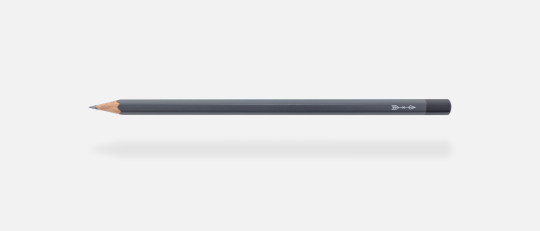
As far as pencils are concerned, I’m a late adapter. I made the switch from a fountain pen (how pretentious, I know) after finishing an essay by Mary Norris on her quest for the ideal No. 1 pencil (contrary to the cabal of No. 2 makers at Ticonderoga, they do exist, and are nigh impossible to find). It shows how deep pencil-freak culture goes that if you’re too occupied to maintain your pencil-point, you have the option of mailing your dulled graphite to David Rees, author of How to Sharpen Your Pencil, to be professionally sharpened. But is there anything more to be said about pencils? Can the pencil be re-conceptualized?
For minimalist pencil-designed Joey Cofone, the answer is an all-caps yes to both questions. Cofone has taken 1st place in the 2013 AIGA CMD-X competition, while Print Magazine named him one of 15 designers under 30 to watch.
The thing to understand first off about Cofone is that he likes simplicity a lot. The co-founder of Baron Fig, a New York-based maker of notebooks, Cofone has recently delved into reinventing the pencil. Or revolutionizing it. At the very least, he’s produced a damn fine instrument to write with and to hold.
The fittingly named Archer has a design that’s extremely clean-lined, forsaking the ferrule and even the eraser in pursuit of lightweight practicality. It’s also incredibly aromatic.
—Michael Peck
THE BELIEVER: What got you into paper and notebooks?
JOEY COFONE: Several years ago, back at the School of Visual Arts here in New York City, I had realization that changed my life. Walking through the design department and taking a look at my fellow classmates’ tools, I noticed something: each of us was using two tools—a laptop and a notebook—to design. The laptops were all the same, MacBooks, but the notebooks were all different brands, sizes, paper types, and so on. I was intrigued. Why was there ubiquity with one tool but no loyalty to the other?
I went home and checked out my own bookshelf, and lo’ and behold all of my notebooks were different. There was this unspoken search for the right notebook that was going on all around me. Eventually my Co-founder Adam Kornfield joined the mix, and together we talked to thinkers all over the world, asking them one question: What do you like in a sketchbook or notebook?
Out of the five hundred plus cold-emails, we received a whopping 80% response rate. It turns out others were on the same search as us—and they had a lot to say. We used all that feedback to design the first community-inspired notebook, the Confidant, and put it on Kickstarter. At the...
You have reached your article limit
Sign up for a digital subscription and continue reading all new issues, plus our entire archives, for just $1.50/month.
Already a subscriber? Sign in




